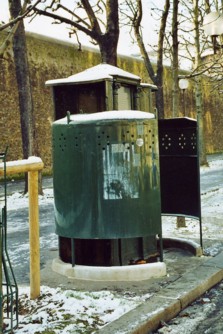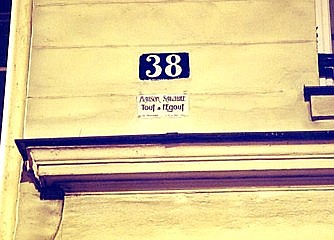Coping
with the call of nature
13th
arrondissement - corner of Boulevard
Arago and rue de la Santé
 OK,
I'm cheating here. This little beaut, the last "vespasienne" in Paris,
is actually situated in the 14th arrondissement, but is only 50 metres from
its junction with the 13th. And since there is nothing more depressing than
exactitude…. Behind you can see the walls of the most famous prison in France,
La Santé.
OK,
I'm cheating here. This little beaut, the last "vespasienne" in Paris,
is actually situated in the 14th arrondissement, but is only 50 metres from
its junction with the 13th. And since there is nothing more depressing than
exactitude…. Behind you can see the walls of the most famous prison in France,
La Santé.
The Paris vespasiennes, or
public urinals, go back to the 1830s, when the city prefect, Rambuteau, decided
to finally do something about the extraordinary filth of the city by building
what were initially called "colonnes Rambuteau". By 1843, there were
478 of them scattered around the city. Their name comes from the Roman emperor
Vespasian (9-79 AD), who built a network of public toilets in Rome and charged
every household an annual tax for their use. The vespasienne was a very
necessary addition to a densely populated city that was decades behind its European
peers in terms of hygiene, most notably London. As recently as 1832, 20,000
people died from cholera in the city. How filthy Paris was can also be gauged
from readingthe massive Tableau de Paris written by the greatest chronicler
of 18th century Paris life, Louis-Sébastien Mercier (1740-1814). "The most
inconvenient thing about carriage entrances [portes-cochères]", he writes,
"is that every passer-by releases his waters there and at the bottom of every
stairway one finds a pisser who just looks at you and carries on undisturbed."
Not an awful lot has changed. There is hardly a corridor in the Metro system
where one does not run the risk of being overcome by the whiff of urine. Merci
les clochards!
Alas, the vespasiennes quickly
became ideal meeting places for homosexuals, who nicknamed them théières,
or tasses. In 1961, the city council decided progressively to get rid
of them, though many survived right through to the early 1980s. Generally, you
smelled them before you saw them.
 More
serious operations, known in polite circles as les Pays-Bas, also were
the source of disposal problems, right through to the second World War. In effect,
mains drainage, the tout à l'égout, was long the preserve of the beaux
quartiers, leaving the rest of Paris in thrall to one of the most ancient
and powerful of the city's corporations, that of the vidangeurs (not
to be confused with the vendangeurs) . The job of the vidangeurs,
who generally operated in teams of four or five, was to empty the city's cesspools,
which were underneath quiet residential streets. This they did at the dead of
night, in an enormous fracas of horses, chains and steam pumps. Needless to
say, the smell was overpowering. In the early 1930s, the Hungarian photographer
Brassaï accompanied a group of vidangeurs one night. At around 3am they
broke off for a snack and met with other vidangeurs in an all-night café
in the Marais. "Without even washing their hands," wrote Brassaï,
"they ravenously tore into their snacks of cheese and sausage and gulped
down the glasses of cheap plonk that the café owner poured them."
In the circumstances, it is easy to see that a connection to the mains drainage
was a key selling point for property until relatively recently. Hence one still
sees little enamel plaques like the one in the photograph above (spotted in
the 3rd arrondissement, it reads Maison salubre - tout à l'égout).
More
serious operations, known in polite circles as les Pays-Bas, also were
the source of disposal problems, right through to the second World War. In effect,
mains drainage, the tout à l'égout, was long the preserve of the beaux
quartiers, leaving the rest of Paris in thrall to one of the most ancient
and powerful of the city's corporations, that of the vidangeurs (not
to be confused with the vendangeurs) . The job of the vidangeurs,
who generally operated in teams of four or five, was to empty the city's cesspools,
which were underneath quiet residential streets. This they did at the dead of
night, in an enormous fracas of horses, chains and steam pumps. Needless to
say, the smell was overpowering. In the early 1930s, the Hungarian photographer
Brassaï accompanied a group of vidangeurs one night. At around 3am they
broke off for a snack and met with other vidangeurs in an all-night café
in the Marais. "Without even washing their hands," wrote Brassaï,
"they ravenously tore into their snacks of cheese and sausage and gulped
down the glasses of cheap plonk that the café owner poured them."
In the circumstances, it is easy to see that a connection to the mains drainage
was a key selling point for property until relatively recently. Hence one still
sees little enamel plaques like the one in the photograph above (spotted in
the 3rd arrondissement, it reads Maison salubre - tout à l'égout).
 Return
to home page
Return
to home page  To
top of the page
To
top of the page
 OK,
I'm cheating here. This little beaut, the last "vespasienne" in Paris,
is actually situated in the 14th arrondissement, but is only 50 metres from
its junction with the 13th. And since there is nothing more depressing than
exactitude…. Behind you can see the walls of the most famous prison in France,
La Santé.
OK,
I'm cheating here. This little beaut, the last "vespasienne" in Paris,
is actually situated in the 14th arrondissement, but is only 50 metres from
its junction with the 13th. And since there is nothing more depressing than
exactitude…. Behind you can see the walls of the most famous prison in France,
La Santé. More
serious operations, known in polite circles as les Pays-Bas, also were
the source of disposal problems, right through to the second World War. In effect,
mains drainage, the tout à l'égout, was long the preserve of the beaux
quartiers, leaving the rest of Paris in thrall to one of the most ancient
and powerful of the city's corporations, that of the vidangeurs (not
to be confused with the vendangeurs) . The job of the vidangeurs,
who generally operated in teams of four or five, was to empty the city's cesspools,
which were underneath quiet residential streets. This they did at the dead of
night, in an enormous fracas of horses, chains and steam pumps. Needless to
say, the smell was overpowering. In the early 1930s, the Hungarian photographer
Brassaï accompanied a group of vidangeurs one night. At around 3am they
broke off for a snack and met with other vidangeurs in an all-night café
in the Marais. "Without even washing their hands," wrote Brassaï,
"they ravenously tore into their snacks of cheese and sausage and gulped
down the glasses of cheap plonk that the café owner poured them."
In the circumstances, it is easy to see that a connection to the mains drainage
was a key selling point for property until relatively recently. Hence one still
sees little enamel plaques like the one in the photograph above (spotted in
the 3rd arrondissement, it reads Maison salubre - tout à l'égout).
More
serious operations, known in polite circles as les Pays-Bas, also were
the source of disposal problems, right through to the second World War. In effect,
mains drainage, the tout à l'égout, was long the preserve of the beaux
quartiers, leaving the rest of Paris in thrall to one of the most ancient
and powerful of the city's corporations, that of the vidangeurs (not
to be confused with the vendangeurs) . The job of the vidangeurs,
who generally operated in teams of four or five, was to empty the city's cesspools,
which were underneath quiet residential streets. This they did at the dead of
night, in an enormous fracas of horses, chains and steam pumps. Needless to
say, the smell was overpowering. In the early 1930s, the Hungarian photographer
Brassaï accompanied a group of vidangeurs one night. At around 3am they
broke off for a snack and met with other vidangeurs in an all-night café
in the Marais. "Without even washing their hands," wrote Brassaï,
"they ravenously tore into their snacks of cheese and sausage and gulped
down the glasses of cheap plonk that the café owner poured them."
In the circumstances, it is easy to see that a connection to the mains drainage
was a key selling point for property until relatively recently. Hence one still
sees little enamel plaques like the one in the photograph above (spotted in
the 3rd arrondissement, it reads Maison salubre - tout à l'égout).
 Return
to home page
Return
to home page To
top of the page
To
top of the page